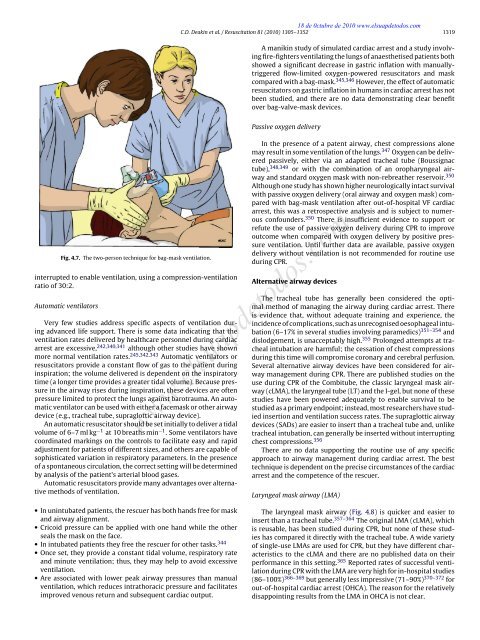European Resuscitation Council Guidelines for Resuscitation ... - CPR
European Resuscitation Council Guidelines for Resuscitation ... - CPR
European Resuscitation Council Guidelines for Resuscitation ... - CPR
Create successful ePaper yourself
Turn your PDF publications into a flip-book with our unique Google optimized e-Paper software.
18 de 0ctubre de 2010 www.elsuapdetodos.comC.D. Deakin et al. / <strong>Resuscitation</strong> 81 (2010) 1305–1352 1319A manikin study of simulated cardiac arrest and a study involvingfire-fighters ventilating the lungs of anaesthetised patients bothshowed a significant decrease in gastric inflation with manuallytriggeredflow-limited oxygen-powered resuscitators and maskcompared with a bag-mask. 345,346 However, the effect of automaticresuscitators on gastric inflation in humans in cardiac arrest has notbeen studied, and there are no data demonstrating clear benefitover bag-valve-mask devices.Passive oxygen deliveryFig. 4.7. The two-person technique <strong>for</strong> bag-mask ventilation.interrupted to enable ventilation, using a compression-ventilationratio of 30:2.Automatic ventilatorsVery few studies address specific aspects of ventilation duringadvanced life support. There is some data indicating that theventilation rates delivered by healthcare personnel during cardiacarrest are excessive, 242,340,341 although other studies have shownmore normal ventilation rates. 245,342,343 Automatic ventilators orresuscitators provide a constant flow of gas to the patient duringinspiration; the volume delivered is dependent on the inspiratorytime (a longer time provides a greater tidal volume). Because pressurein the airway rises during inspiration, these devices are oftenpressure limited to protect the lungs against barotrauma. An automaticventilator can be used with either a facemask or other airwaydevice (e.g., tracheal tube, supraglottic airway device).An automatic resuscitator should be set initially to deliver a tidalvolume of 6–7 ml kg −1 at 10 breaths min −1 . Some ventilators havecoordinated markings on the controls to facilitate easy and rapidadjustment <strong>for</strong> patients of different sizes, and others are capable ofsophisticated variation in respiratory parameters. In the presenceof a spontaneous circulation, the correct setting will be determinedby analysis of the patient’s arterial blood gases.Automatic resuscitators provide many advantages over alternativemethods of ventilation.In the presence of a patent airway, chest compressions alonemay result in some ventilation of the lungs. 347 Oxygen can be deliveredpassively, either via an adapted tracheal tube (Boussignactube), 348,349 or with the combination of an oropharyngeal airwayand standard oxygen mask with non-rebreather reservoir. 350Although one study has shown higher neurologically intact survivalwith passive oxygen delivery (oral airway and oxygen mask) comparedwith bag-mask ventilation after out-of-hospital VF cardiacarrest, this was a retrospective analysis and is subject to numerousconfounders. 350 There is insufficient evidence to support orrefute the use of passive oxygen delivery during <strong>CPR</strong> to improveoutcome when compared with oxygen delivery by positive pressureventilation. Until further data are available, passive oxygendelivery without ventilation is not recommended <strong>for</strong> routine useduring <strong>CPR</strong>.Alternative airway devicesThe tracheal tube has generally been considered the optimalmethod of managing the airway during cardiac arrest. Thereis evidence that, without adequate training and experience, theincidence of complications, such as unrecognised oesophageal intubation(6–17% in several studies involving paramedics) 351–354 anddislodgement, is unacceptably high. 355 Prolonged attempts at trachealintubation are harmful; the cessation of chest compressionsduring this time will compromise coronary and cerebral perfusion.Several alternative airway devices have been considered <strong>for</strong> airwaymanagement during <strong>CPR</strong>. There are published studies on theuse during <strong>CPR</strong> of the Combitube, the classic laryngeal mask airway(cLMA), the laryngeal tube (LT) and the I-gel, but none of thesestudies have been powered adequately to enable survival to bestudied as a primary endpoint; instead, most researchers have studiedinsertion and ventilation success rates. The supraglottic airwaydevices (SADs) are easier to insert than a tracheal tube and, unliketracheal intubation, can generally be inserted without interruptingchest compressions. 356There are no data supporting the routine use of any specificapproach to airway management during cardiac arrest. The besttechnique is dependent on the precise circumstances of the cardiacarrest and the competence of the rescuer.www.elsuapdetodos.comLaryngeal mask airway (LMA)• In unintubated patients, the rescuer has both hands free <strong>for</strong> maskand airway alignment.• Cricoid pressure can be applied with one hand while the otherseals the mask on the face.• In intubated patients they free the rescuer <strong>for</strong> other tasks. 344• Once set, they provide a constant tidal volume, respiratory rateand minute ventilation; thus, they may help to avoid excessiveventilation.• Are associated with lower peak airway pressures than manualventilation, which reduces intrathoracic pressure and facilitatesimproved venous return and subsequent cardiac output.The laryngeal mask airway (Fig. 4.8) is quicker and easier toinsert than a tracheal tube. 357–364 The original LMA (cLMA), whichis reusable, has been studied during <strong>CPR</strong>, but none of these studieshas compared it directly with the tracheal tube. A wide varietyof single-use LMAs are used <strong>for</strong> <strong>CPR</strong>, but they have different characteristicsto the cLMA and there are no published data on theirper<strong>for</strong>mance in this setting. 365 Reported rates of successful ventilationduring <strong>CPR</strong> with the LMA are very high <strong>for</strong> in-hospital studies(86–100%) 366–369 but generally less impressive (71–90%) 370–372 <strong>for</strong>out-of-hospital cardiac arrest (OHCA). The reason <strong>for</strong> the relativelydisappointing results from the LMA in OHCA is not clear.
















